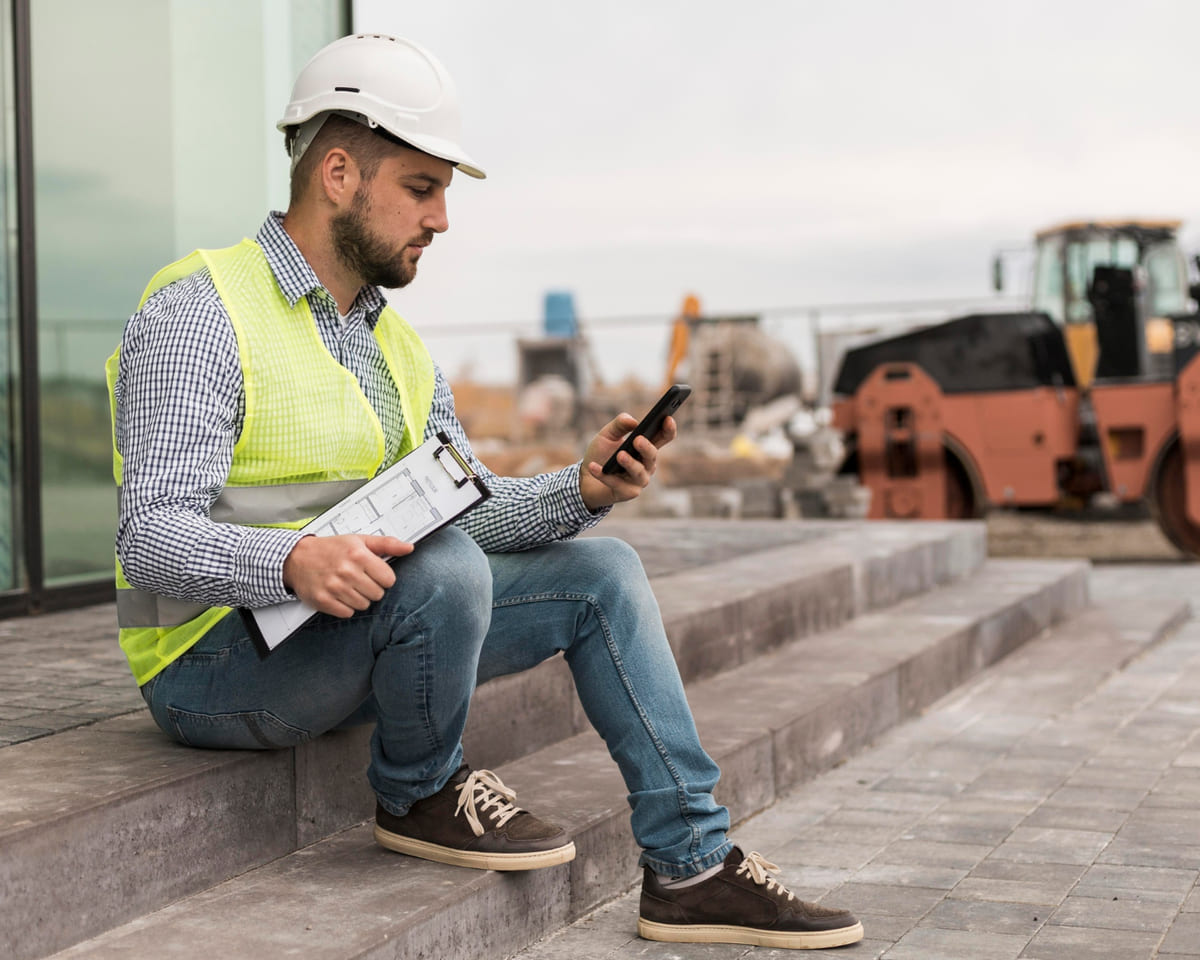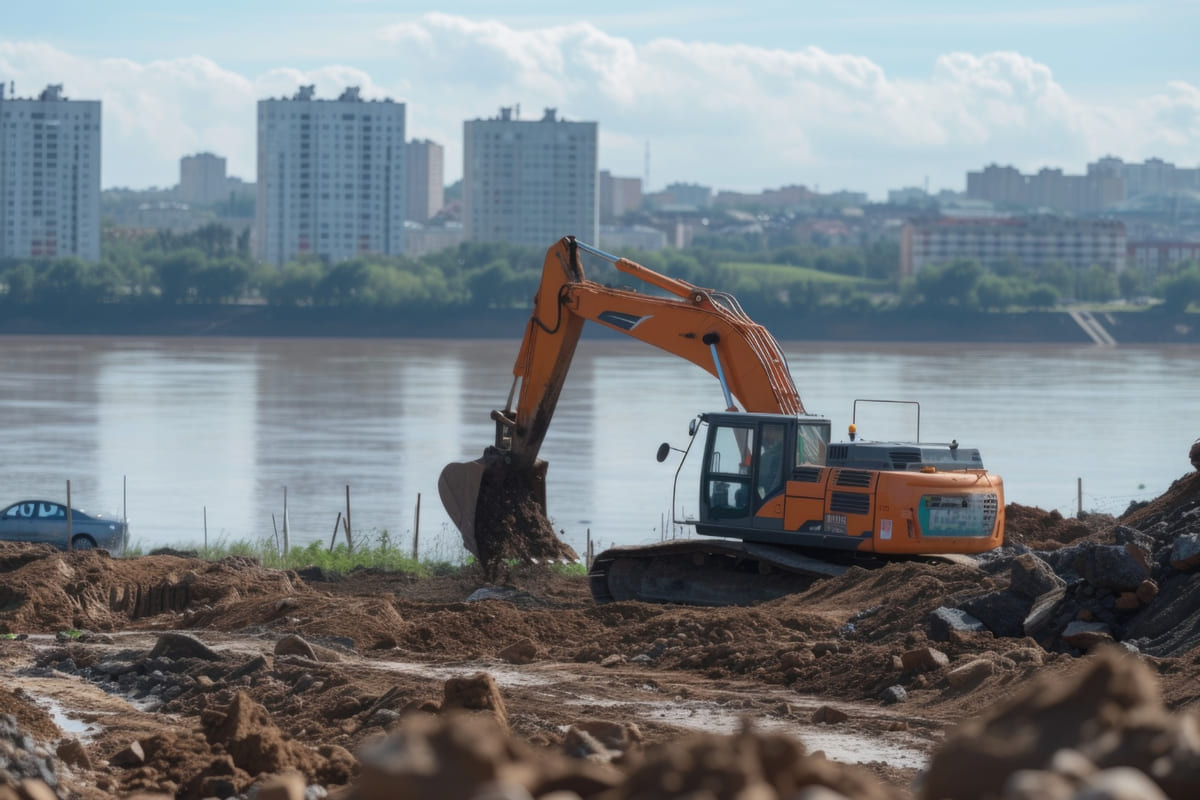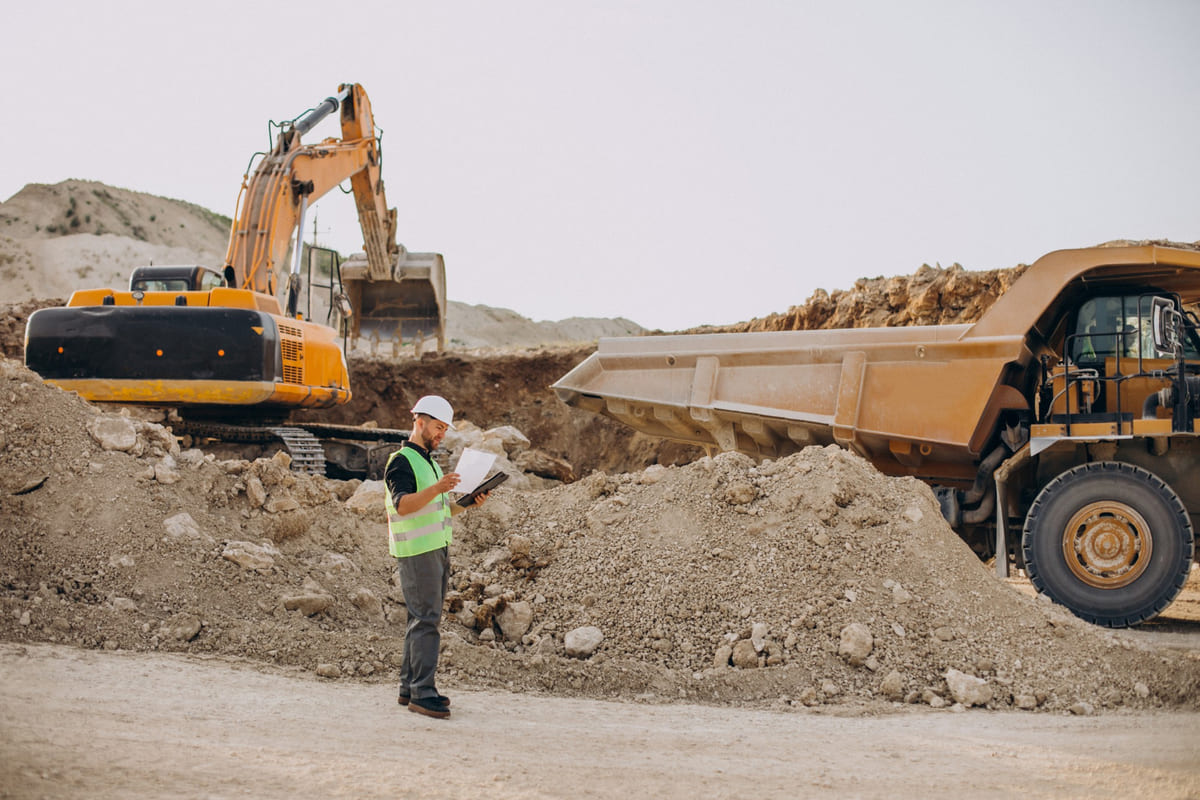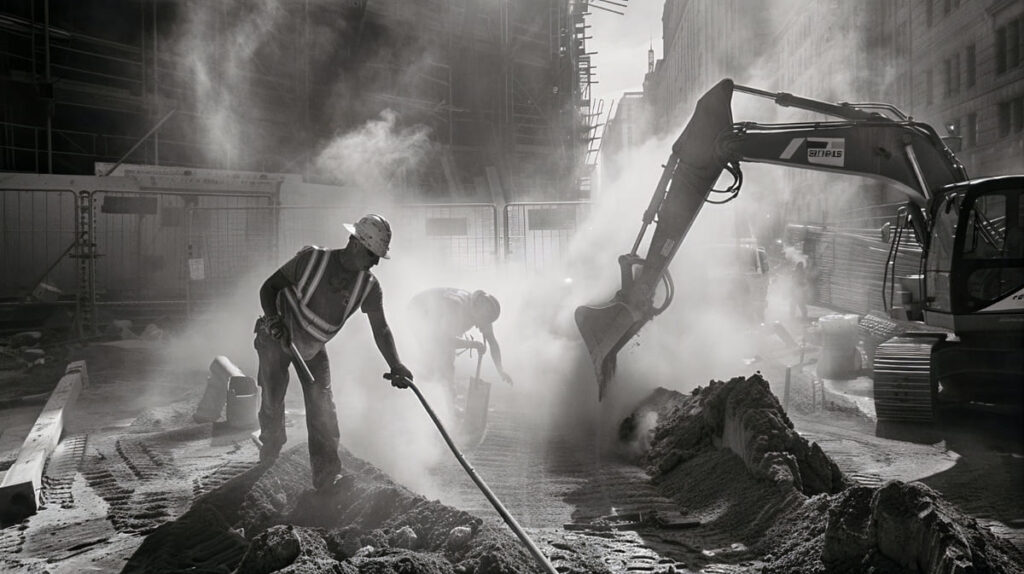Large-scale construction projects are bustling environments with heavy machinery, blasting, and constant activity. All this activity creates vibrations – the subtle pulse of a construction site. Monitoring these vibrations is crucial. Vibration sensors act like the project’s stethoscope, continuously measuring oscillations in structures, equipment, and the ground. By “listening” to the site’s vibration pulse, engineers and safety officers can detect issues early, prevent damage, and ensure everything runs smoothly. This article explores five critical applications of vibration sensors on large construction sites in Europe, illustrating how they enhance structural safety, machine reliability, regulatory compliance, worker health, and long-term project success.
Table of Contents
5 Critical Applications of Vibration Sensors on Large-Scale Sites
1. Structural Integrity Monitoring
Protecting nearby buildings and infrastructure from construction-induced vibrations is a top priority on urban European projects. Activities like rock blasting, pile driving, or demolition can send shock waves through the ground that threaten the stability of adjacent structures. Vibration sensors are deployed on existing buildings, bridges, or sensitive facilities next to the site to track these vibrations in real time. Typically, robust geophone sensors or accelerometers are mounted at the foundation or structural elements of the neighboring asset. They measure parameters such as Peak Particle Velocity (PPV) – a key indicator of vibration intensity – to ensure vibrations stay below safe limits defined by standards (for example, Germany’s DIN 4150-3 or the UK’s BS 5228-2 in Europe).
How it works: If excavation or heavy piling starts to generate vibration levels approaching threshold values, the monitoring system triggers alerts. Site managers can then adjust or pause activities to prevent structural damage. For instance, during tunnel construction under a historic city center, engineers might slow down a tunnel boring machine when sensors on an overlying heritage building show vibration nearing the allowable limit.
Typical Vibration-Induced Structural Issues:
-
Cracks in walls or masonry: High-frequency vibrations can cause cracking in brittle materials like plaster, concrete, and brickwork, endangering structural components.
-
Differential settlement: Prolonged ground vibrations may lead to soil compaction or shifting, causing uneven settlement of foundations nearby.
-
Fatigue in structural elements: Repeated low-level vibrations can gradually weaken beams, joints, or connections through material fatigue over time.
By continuously monitoring these parameters, construction teams avoid costly damage to third-party structures. In Europe’s dense urban areas – often filled with centuries-old buildings – such structural integrity monitoring is not just good practice but frequently a legal requirement in project permits. Overall, this application of vibration sensors gives engineers the data to preserve surrounding infrastructure and maintain public trust during ambitious construction projects.
Suggested article to read: Types of Sensors in Construction Industry; 2024 Review

2. Machinery and Equipment Maintenance
On a large construction site, myriad heavy machines are at work – tower cranes, excavators, generators, compressors, and more. Keeping this equipment in peak condition is essential for project timelines and safety. Vibration sensors play a key role in predictive maintenance of construction machinery. By attaching accelerometers to critical components (engines, gearboxes, pump motors, etc.), maintenance teams can continuously monitor the health of the equipment. Unusual vibration patterns often serve as early warning signs of mechanical issues, allowing intervention before a breakdown occurs.
For example, consider a high-capacity concrete pump operating on a busy construction site. If a vibration sensor on the pump’s motor detects increasing oscillation amplitudes or abnormal frequency spikes, it may indicate problems such as an imbalanced rotor or a worn bearing. Maintenance crews receiving these alerts can schedule a repair or part replacement during planned downtime, rather than facing a sudden machinery failure during a concrete pour. This predictive maintenance approach minimizes unplanned downtime that could delay the project.
Common Equipment Faults Identified by Vibration:
-
Imbalanced or misaligned components: Excessive vibration may signify that rotating parts (like crane winch drums or pump impellers) are unbalanced or misaligned, a condition that can lead to rapid wear.
-
Bearing wear and damage: A failing bearing in a motor or gearbox often produces a distinctive vibration signature (e.g. higher frequency vibration). Sensors catch this early so the bearing can be replaced to prevent a major failure.
-
Loose or damaged parts: Vibrations can increase if bolts, mounts, or structural elements of a machine come loose or crack. Monitoring alerts staff to fix or tighten components before they fall off or cause an accident.
-
Resonance issues: If a machine starts vibrating at its natural frequency, it can amplify motions and self-damage. Sensors help detect and avoid these harmful resonant vibration conditions.
European construction companies are increasingly using such vibration-based condition monitoring systems across their fleets of equipment. Not only does this improve reliability, but it also enhances safety – a well-monitored machine is far less likely to fail catastrophically. In fact, studies show that about 90% of machinery can benefit from vibration monitoring for maintenance, underscoring how broadly this application can be applied on job sites. By keeping critical equipment healthy, vibration sensors help contractors stick to schedules and avoid the hefty costs associated with equipment downtime or replacement.
3. Ground Vibration Control and Environmental Impact
Construction vibrations don’t just affect structures and machines – they also impact the surrounding environment and community. In Europe, where construction sites often coexist near offices, homes, and sensitive facilities, managing the environmental impact of vibrations is crucial for both compliance and public relations. Vibration sensors are widely used to monitor ground-borne vibrations and ensure they remain within acceptable levels for human comfort and the protection of nearby infrastructure.
One key application is in controlling vibrations from activities like demolition blasting, jackhammering, or vibratory compaction so they do not disturb neighbors or damage buried utilities. Sensors placed at the site perimeter or on nearby buildings provide continuous data on vibration levels transmitted through the soil. If the vibration exceeds predefined limits, the system can automatically alert site managers. Modern monitoring setups even send instant SMS or email alerts when thresholds are crossed, prompting immediate action (for example, halting a blasting sequence or modifying construction techniques). This real-time control loop helps contractors adapt methods on the fly – perhaps using smaller charges in a blast or scheduling heavy work for times that minimize disturbance.
Major Sources of Construction Vibration:
-
Blasting and demolition: Explosive demolition or rock blasting produces short, high-intensity vibration bursts that can propagate through the ground and air, potentially shattering windows or cracking facades if not controlled.
-
Pile driving and drilling: Repeated hammering from pile drivers or vibratory sheet pile installation generates continuous vibrations that travel through soil and rock to adjacent structures.
-
Vibratory compaction: Heavy rollers and compactors use vibration to densify soil (a needed process for stability), but this can send strong tremors outward from the site.
-
Heavy vehicle traffic: The passage of fully loaded trucks or tracked excavators can cause low-frequency ground tremors, especially on uneven surfaces or temporary haul roads.

By monitoring these sources, project teams aim to keep vibration levels below damaging or annoying thresholds. For example, human occupants can feel and be disturbed by vibrations at very low levels (vibrations on the order of 0.1 mm/s PPV are barely perceptible, while a few millimeters per second can rattle dishes or disrupt sleep). Often, the permissible vibration limits for human comfort are far stricter than those for structural damage. Thus, vibration sensors help balance progress with community comfort – ensuring that while construction “makes waves,” it doesn’t spark a flood of noise/vibration complaints.
In practice, this application is tightly linked to regulatory compliance. Many European cities mandate vibration monitoring as part of environmental management plans for large projects, especially near residential areas or heritage sites. The data recorded by sensors provides documentation to demonstrate compliance with local vibration limits and can be included in reports to city authorities. It also serves as evidence to swiftly resolve any claims that construction activity caused damage – with an objective record, false claims can be dismissed and genuine issues addressed promptly. Overall, ground vibration monitoring safeguards the environment and maintains good relations with the public, all while keeping the project within legal bounds.
4. Worker Safety and Comfort
While much focus is on structures and neighbors, vibration sensors are equally important for safeguarding the health of construction workers themselves. Construction crews often use powerful handheld tools (like jackhammers, drills, and compactors) and operate heavy vehicles that transmit vibrations to their bodies. Prolonged exposure to high vibration levels can lead to serious occupational illnesses. In the European Union, strict regulations (the Physical Agents (Vibration) Directive) require employers to assess and control workers’ exposure to vibration. Vibration sensors are the tools that make this possible, enabling accurate measurement of what workers feel and guiding measures to protect them.
Hand-arm vibration syndrome (HAVS) is a well-known risk for workers who regularly use vibrating tools. This condition involves nerve damage and circulatory problems (such as “vibration white finger”) caused by chronic vibration exposure to the hands and arms. Similarly, long-term whole-body vibration – for instance, experienced by drivers of bulldozers or dump trucks over rough terrain – can contribute to lower back pain and spinal issues. Vibration monitoring devices help track these exposures. Small wearable sensors or specialized vibration dosimeters can be attached to tools or carried by workers to log the acceleration levels and duration of exposure throughout a shift.
Health Conditions Linked to Excessive Vibration Exposure:
-
Hand-Arm Vibration Syndrome (HAVS): Nerve and blood vessel damage in the fingers and hands, causing numbness, tingling, and loss of grip strength. This often results from years of using high-vibration power tools without adequate protection.
-
Vibration White Finger: A component of HAVS, where fingers blanch (turn white) due to poor circulation. It can become painful and disabling in cold conditions.
-
Musculoskeletal Disorders: Whole-body vibration can accelerate degeneration of spinal discs and joints, contributing to chronic back pain and other musculoskeletal problems in construction machine operators.
Using vibration sensor data, safety officers can implement controls to minimize these risks. For example, if measurements show that a jackhammer operator would exceed the EU’s daily exposure action value (2.5 m/s² A(8) for hand-arm vibration) after a certain number of hours, the site can mandate more frequent breaks or rotate tasks among workers to stay within safe limits. Tools with lower vibration emissions may be selected, and anti-vibration gloves or damping handles can be provided. The sensors verify whether such interventions are effective by comparing exposure levels before and after changes.
Statistics highlight why this application is so critical: it’s estimated that in Europe between 14% and 34% of workers across various industries are exposed to potentially harmful vibrations, and the construction sector has one of the highest exposure rates (with roughly 63% of construction workers affected). Thanks to vibration monitoring and improved awareness, conditions like HAVS are now recognized earlier or prevented altogether by enforcing exposure limits. In summary, vibration sensors help create a safer workplace by quantifying an invisible hazard, allowing construction firms to protect their workforce’s health in line with European occupational safety regulations.
5. Long-Term Structural Health Monitoring and Insights
Vibration sensors not only provide immediate safeguards during construction – they also contribute to the long-term health and performance of structures well after the project is completed. This application involves using vibration data for structural health monitoring (SHM) and for refining construction practices through data-driven insights. In Europe’s push for sustainable, resilient infrastructure, many large projects integrate sensors from the construction phase onward to “future-proof” the results.
One aspect is post-construction analysis. The vibration records collected while building a structure (such as a bridge or high-rise) serve as a baseline of its behavior under known conditions. Engineers can analyze this data to identify the structure’s natural frequencies and damping characteristics. Any significant changes in these vibration properties over time might indicate the onset of structural issues (for example, a reduction in natural frequency could suggest a loss of stiffness due to a crack or material degradation).
By installing permanent vibration sensors in critical components, owners can continuously monitor the “heartbeat” of the structure throughout its service life. Many modern bridges, for instance, include accelerometers on their spans to detect unusual vibrations caused by traffic or wind. If something deviates from the norm – say, one segment of a bridge begins vibrating more strongly than it used to under the same truck loads – maintenance crews are alerted to inspect for damage or wear at an early stage.
Another aspect is leveraging vibration data to optimize construction techniques and design. All the information gathered by sensors on large-scale sites feeds into a growing knowledge base. Contractors and engineers review this data to learn which methods kept vibrations lowest or which sequences of work caused spikes. These insights can influence future projects: for example, if data shows that a certain type of pile driving hammer consistently stayed within vibration limits without pausing work, that method may be favored in similar soil conditions elsewhere, improving efficiency while staying safe.

On the other hand, any incident of vibration-related damage or alarm becomes a case study to avoid repeating those conditions. Over time, this leads to smarter planning (choosing equipment and methods that produce fewer vibrations) and better risk mitigation strategies across the construction industry.
Technological advancements are enhancing this long-term monitoring application. Wireless IoT vibration sensors with long battery life can remain in place for months or years, transmitting data to cloud platforms for remote analysis. Engineers across Europe can log into web dashboards to check the vibration status of multiple sites or structures in real time, even long after construction is finished. Additionally, AI and machine learning algorithms are being applied to big vibration datasets to detect subtle patterns that humans might miss.
For example, an AI system could be trained to recognize the early vibration signature of a developing fault in a structure or to correlate certain construction activities with minor vibration anomalies, prompting preventive action. These smart analytics tools transform raw sensor data into actionable maintenance alerts or design improvements, truly “monitoring the pulse” of infrastructure continuously.
In summary, integrating vibration sensors for long-term monitoring ensures that the benefits of construction-phase measurements extend into the operational life of the structure. It provides ongoing assurance that bridges, buildings, and other large assets remain safe and sound. Moreover, it creates a feedback loop where lessons learned from one project’s data improve the next project’s safety and efficiency. This forward-looking use of vibration sensors closes the circle – from construction to operation – solidifying their role as an indispensable part of modern engineering practice.
FAQs
How do vibration sensors improve safety on construction sites?
Vibration sensors improve safety by acting as an early warning system for potential problems. They can detect excessive vibrations from heavy equipment or blasting and alert engineers before structural damage or accidents occur. For example, sensors on a crane can reveal developing mechanical issues so maintenance can be done before a failure causes a safety incident. Similarly, sensors monitoring a nearby building will warn the team if construction vibrations approach unsafe levels, allowing work to pause and prevent harm. In essence, these devices help construction teams proactively manage risks to structures, equipment, and people.
What are the key applications of vibration sensors in construction?
Key applications of vibration sensors in construction include: structural monitoring of buildings and bridges to prevent damage, machine condition monitoring for predictive maintenance of equipment, ground vibration monitoring to protect the surrounding community and infrastructure, worker exposure monitoring to ensure crews aren’t harmed by excessive tool or vehicle vibrations, and long-term structural health monitoring to use data collected for future maintenance and safety improvements. These applications cover the full spectrum of project needs – from immediate safety during construction to the ongoing integrity of the completed structure.
Which types of vibration sensors are used in construction projects?
Construction projects typically use rugged accelerometers and geophones as vibration sensors. Accelerometers (often piezoelectric or MEMS-based) measure acceleration and are commonly attached to machinery or structures to capture high-frequency vibrations in three axes (X, Y, Z). Geophones, on the other hand, are velocity sensors often used in ground monitoring; they are planted in soil or attached to foundations to measure ground tremors (peak particle velocity). Modern vibration monitoring units usually combine tri-axial accelerometers or geophones with data loggers and wireless transmitters.
For measuring human vibration exposure, portable human vibration meters or wearable sensors are used. In summary, whether it’s a small wireless accelerometer on a motor or a anchored geophone for building protection, construction sites deploy a range of sensor types optimized for tough field conditions and accurate vibration readings.
Is it true that vibration monitoring on construction sites is legally required in Europe?
Yes, in many cases European regulations make vibration monitoring a legal necessity on construction sites. There are two main aspects: occupational safety laws and environmental protection rules. For worker safety, the EU’s vibration directive (2002/44/EC) requires employers to assess and limit workers’ vibration exposure – practically, this means using vibration measurements to ensure limits (such as a daily exposure limit of 5.0 m/s² for hand-arm vibration) are not exceeded. On the environmental side, many local building codes and project permits mandate vibration monitoring when construction occurs near sensitive structures or residential areas.
Authorities in European cities often require contractors to implement a vibration management plan with continuous monitoring, especially for activities like pile driving or demolition. Even when not explicitly required by law, having vibration sensors in place is considered best practice to comply with broader safety regulations and to document that the construction company took due diligence to prevent harm. In short, while the exact requirements can vary by country and project, using vibration monitoring is both a legal compliance measure and an industry-standard approach on large European construction sites.
Conclusion
Vibration sensors are an essential technology for today’s large-scale construction projects, especially across the European construction industry where safety and precision are paramount. By monitoring the pulse of construction, these sensors provide real-time insights into the forces at play on a site. We have seen how they are applied to protect structural integrity, keep machinery running reliably, ensure compliance with vibration limits, safeguard workers’ health, and gather data for the future. In each of the five critical applications discussed, the common theme is risk management: identifying potential problems through vibration monitoring before they escalate into costly failures or hazards
With clear, didactic examples – from preventing cracks in a neighboring building to predicting a bulldozer’s maintenance needs – we see that vibration sensors empower construction professionals to make informed decisions. In practice, they act as an early warning system and a quality control tool combined. As construction projects continue to grow in scale and complexity, vibration sensors will remain at the heart of site monitoring, ensuring that projects progress safely, smoothly, and in harmony with their surroundings.
Resources:
-
Encardio-Rite. (2023). The Importance of Vibration Monitoring in Construction Encardio-Rite Blog.
-
GEO-Instruments. (n.d.). Vibration Monitoring Guide – Part 1: Construction Vibration Overview. GEO-Instruments, Inc.
-
Sonitus Systems. (2024). Vibration Limits for Construction Sites – Insights. Sonitus Systems Blog.
-
UpKeep Technologies. (2020). What are common use cases for using a vibration sensor in predictive maintenance? UpKeep Learning Center. Available at:
-
IOSH Magazine. (2022). Vibration safety for workers (Statistics on European worker vibration exposure).
For all the pictures: Freepik
Suggested article for reading:
IoT Building Automation Systems; 2025 Ultimate Guide
How Predictive Maintenance IoT Reduces Unplanned Downtime in Construction: 4 Case Studies
5 Essential IoT Applications in Building Automation Systems
Top 7 IoT Building Automation Trends Transforming Smart Buildings
7 Steps to Strengthen Building Automation Cybersecurity





